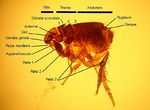Difference between revisions of "Ctenocephalides felis"
Jump to navigation
Jump to search
| Line 7: | Line 7: | ||
==Identification== | ==Identification== | ||
| − | The adults ar dark-brown, and have fascicles and laciniae adapted for piercing skin and sucking blood. | + | The adults ar dark-brown, and have fascicles and laciniae adapted for piercing skin and sucking blood. They have large legs, containing resilin, adapted for jumping, and are laterally flattened, so they can easily move through the hair of the hosts. |
*Most important flea in veterinary medicine | *Most important flea in veterinary medicine | ||
Revision as of 11:36, 19 July 2010
Ctenocephalides felis is the most commonly seen flea on both cats and dogs, it is also an important intermediate host in the parasite Dipylidium caninum.
Hosts
Cats, dogs, and humans.
Identification
The adults ar dark-brown, and have fascicles and laciniae adapted for piercing skin and sucking blood. They have large legs, containing resilin, adapted for jumping, and are laterally flattened, so they can easily move through the hair of the hosts.
- Most important flea in veterinary medicine
- Commonly called the 'cat flea'
- Can bite humans and other animals
- Both genal and pronotal commbs present
- Similar length genal combs
- The first genal spine is 0.75 times the length of the second
- Sloping nose
- 6 notches bearing setae on the dorsal border of the hind tibia
